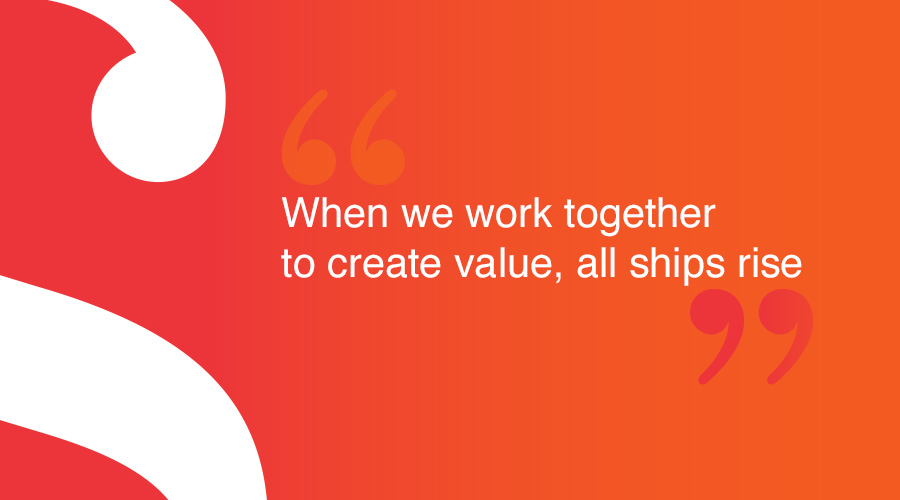Recently, I had the pleasure of presenting a webinar outlining Simantel’s thoughts on changing trends in customer experience strategy, customer experience management and service branding.
During that webinar, we were asked about how to motivate employees to activate and support a company’s CX management strategy. And while I didn’t have too much time to get into it during the webinar, I wanted to provide more context for many marketers out there struggling with this. Because it is important.
(If you attended the webinar, thank you. If not, that’s ok too. Lucky for you, we recorded it).
The truth is, with the expansion of digital, many organizations have started to get away from person-to-person interactions and service models. As companies adopt more digital assistants, automated processes and tools, it is actually making some customer experiences quite fragmented.
Instead of arming their workforce with better solutions to meet and exceed customer needs and expectations, far too many businesses are using these new tools and technologies the same way they’ve treated nearly every new technical disruption coming into fashion: as an opportunity to sell more.
They oversaturate and push additional choices and offers. In many ways, this makes consumers more reluctant to engage with a brand because they’re unable to determine what is valuable and what’s just noise.
Trends are showing us that users are adopting more digital assistants and AI to protect themselves from brand messaging. We see a push back at brands that overcommunicate via digital approaching just as customers are telling us that they want fewer choices and higher confidence in the brands, companies, products and services they’re spending with.
Robert Tas, chief marketing officer of Pegasystems, a CX applications vendor was famously quoted in Forbes saying: “Customer experience is not a technology problem—it’s a culture problem.”
Tas’ quote continues to ring true three years later. A common barrier to better customer experience is when employees feel disconnected with how a company treats and empowers them and the way they’re expected to treat customers.
Impacting Workflow and Customer Interactions
At Simantel, developing solutions beyond campaign-based thinking is part of our process – and it certainly isn’t a new concept for the approach to branding and service design.
When Simantel began helping a transportation logistics client consolidate their brands under a unified brand, G&D Integrated, it was important that their employees understood the “why” behind the rebrand and their role in its successful execution. They were, in fact, the most consistent brand touchpoint to many of their customers. We took training to the front line and helped empower employees to articulate the value of the rebranded company and set expectations for their customers moving forward.
“When we launched G&D Integrated, the company was merging three distinctly branded business units together. So to eliminate brand confusion, increase cross-selling opportunities and improve customer experience, we enabled all employees to become advocates of the new brand at every touchpoint,” recalls Simantel owner and principal Maggie Misselhorn.
Together, we developed tools for everyone from receptionists to drivers to help explain and support the brand. We achieved this through the development of training programs and curriculum, collateral materials that could be used for discussions or handed out by drivers along their routes and conditioning throughout their facilities to underscore key messaging.
“In almost everything that we do, we understand that the internal touchpoints can have the biggest impact on customer success,” says Misselhorn. “How you train employees to react and establish brand value in customer’s frequent touchpoints is just as important as the message itself.”
How to Focus on Employee Engagement
Companies that want to improve their CX strategy need to focus on better engagement with, and through, their employees. Here are four simple steps to start making that happen.
- Engage Regularly with Your Employees
Most companies are not engaging enough with their workforce. Too many rely on annual engagement surveys or the annual review process to get an understanding of how their workforce is coping.
The simple fact is that ad-hoc surveys aren’t conducted with enough regularity to gain an understanding of what matters to employees or what issues they’re seeing in the field.
For employee engagement to help execute a CXM strategy, getting feedback has to be culture based. That means doing it often. That means turning these engagement points into conversations and opportunities to share with employees how their insight is driving change with strategy and programming. This doesn’t only benefit CXM; it’s crucial to helping the team be committed to their work.
- Reward Employees Impacting the CX Strategy
Prioritize the needs of your employees by rewarding them for prioritizing customer happiness and success. Understand what motivates your employees based on the conversations and data points mentioned above and reward employees who go the extra mile with opportunities to impact other service models.
This tactic is exactly how Amazon has moved across numerous categories to become the retail, media and service giant it now is. From humble beginnings of being an online bookseller disrupting Borders and Barnes & Noble, to re-inventing the way mail is delivered and ordering just about anything at the push of a button, Amazon’s culture of rewarding employees for innovating on and making the customer experience better has always been a cornerstone of how they do business.
- Do a Little More with Your Data
Data is the entry point to customer-centricity, but you need humans to help analyze and unlock the value of this data.
Most organizations collecting customer data and feedback are also doing some sort of monitoring of employee satisfaction and/or performance. If your organization is using these tools, consider using them alongside your customer data to create more two-way conversations with your workforce. These conversations are the key to developing products, services and interactions that harness what we do know about our customers and processes to meet and exceed customer expectations.
This approach allows for greater employee investment in the process of managing customer interactions and expectations by arming them with data.
- Get Back to Your Basics
In its simplest form, CX is all about getting back to basics and becoming personal again—and that starts with your employees. Data builds understanding; interactions build trust.
Start with your understanding of the data that customers provide in digital and physical means to build trust with customers and you’ll be rewarded exponentially. Trusting customers provides more data, which, in turn, allows for greater understanding and deeper trust.
Biggest Brand Advocates
Whether you are ready to get started with CX or have already deployed a sophisticated program, don’t forget about the experience of your employees. As marketing is getting back to the basics and becoming customer-centric again, it is easy to skip over employee engagement—when, in fact, they can be your biggest brand advocates.





